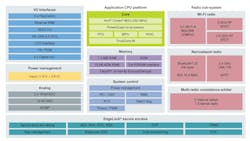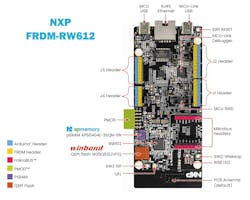A Quick Look at the NXP FRDM-RW612’s Wired and Wireless Capabilities
What you’ll learn:
- What’s in the NXP FRDM-RW612 development kit?
- What tools are available for the RW612?
NXP’s RW612 is a wireless microcontroller that incorporates three different radios, including support for Wi-Fi 6, Bluetooth Low Energy 5.4, and 802.15.4 (Fig. 1). It’s well-suited for building wireless gateways that handle high-end protocols like Matter as well as devices that can take advantage of different wireless communication services.
I was able to take a hands-on look at the NXP FRDM-RW612 Development Kit and its tools (watch the video above).
The chip itself is almost hidden on the board. The RW612 is managed by a 260-MHz Arm Cortex-M33 with TrustZone support and an EdgeLock secure enclave. This supports secure boot, secure debugging, secure updates, and lifecycle management. A physically unclonable function (PUF) tackles secure key management—it’s needed to handle connections to IoT cloud services from most cloud providers.
A quad SPI (QSPI) interface with on-the-fly decryption is used to access off-chip serial memory. Since it supports eXecute in place (XIP), the code doesn’t have to be brought into the 1.2 MB of SRAM. An on-chip ROM handles secure boot from a variety of targets.
>>Check out more Kit Close-up videos
The processor core is augmented with a companion NXP PowerQuad DSP accelerator. This moves some of the CMSIS DSP functionality into hardware to reduce power requirements while increasing performance.
The micro features a host of the usual analog and digital interfaces, including dual 16-bit analog-to-digital converters (ADCs) and a 10-bit digital-to-analog converter (DAC). Also in the mix are a USB 2.0 OTG port and five NXP FlexComm serial interfaces, as well as an Ethernet RMII interface along with SDIO and I2S support.
The wireless side offers dual-band, 802.11ax Wi-Fi 6 with a 20-MHz bandwidth. There’s a 2.4-GHz LNA/PA plus Bluetooth LE with a 802.15.4 MAC. And an on-chip arbiter manages radio operation.
Exploring the NXP FRDM-RW612 Development Kit
The NXP FRDM-RW612 Development Kit is essentially a board (Fig. 2) that comes in a box with little else, as the software is available online. The chip tends to be lost in all of the other electronics and connectors surrounding it. This includes a dedicated USB port for debugging, a USB port for the RW612, Ethernet, and an on-board antenna.
The headers and connectors scattered around the board provide access to almost any de facto standard interface, including Arduino, mikroBUS, and PMOD. The NXP FRDM header is a superset of the Arduino header. The chip is a 3.3 V device, so keep that in mind when considering peripherals. The web-based NXP Expansion Board Hub helps in finding compatible peripherals.
Storage is provided by a 512-Mb (64 MB) Winbond QSPI serial flash memory. There’s also an APMemory 64-Mb, serial QSPI pSRAM.
Development Support for the RW612
The NXP MCUXpresso software suite includes IDEs, libraries, and software support. Two free open-source options are available: the VS Code-based MCUXpresso for Visual Studio and Eclipse-based MCUXpresso IDE. I tend to prefer the latter, but that’s more because I use Eclipse with many other boards. Other IDEs are out there, like the IAR Embedded Workbench, Arm Keil MDK, etc.
The suite includes a host of other tools for functions such as provisioning and debug support. The board comes equipped with a USB-based MCU-Link as well as software debug (SWD)/JTAG interface.
Matter is also part of the puzzle, as is support for RTOSes like Zephyr and the Azure RTOS, now known as Eclipse ThreadX. Of course, there are wireless stacks to handle Wi-Fi, Bluetooth, and 802.15.4.
>>Check out more Kit Close-up videos
About the Author
William G. Wong
Senior Content Director - Electronic Design and Microwaves & RF
I am Editor of Electronic Design focusing on embedded, software, and systems. As Senior Content Director, I also manage Microwaves & RF and I work with a great team of editors to provide engineers, programmers, developers and technical managers with interesting and useful articles and videos on a regular basis. Check out our free newsletters to see the latest content.
You can send press releases for new products for possible coverage on the website. I am also interested in receiving contributed articles for publishing on our website. Use our template and send to me along with a signed release form.
Check out my blog, AltEmbedded on Electronic Design, as well as his latest articles on this site that are listed below.
You can visit my social media via these links:
- AltEmbedded on Electronic Design
- Bill Wong on Facebook
- @AltEmbedded on Twitter
- Bill Wong on LinkedIn
I earned a Bachelor of Electrical Engineering at the Georgia Institute of Technology and a Masters in Computer Science from Rutgers University. I still do a bit of programming using everything from C and C++ to Rust and Ada/SPARK. I do a bit of PHP programming for Drupal websites. I have posted a few Drupal modules.
I still get a hand on software and electronic hardware. Some of this can be found on our Kit Close-Up video series. You can also see me on many of our TechXchange Talk videos. I am interested in a range of projects from robotics to artificial intelligence.



